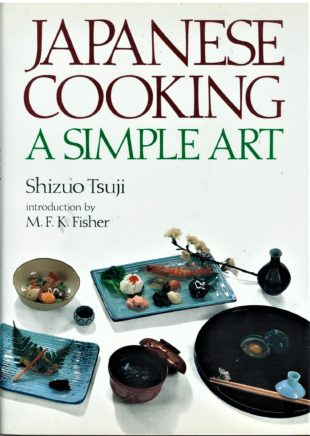Japanese Cooking : A Simple Art – Introduction
Japanese Cooking: A Simple Art by Shizuo Tsuji is a thoughtful and careful book surveying many of the great recipes of Japan. The author was the head of the largest school for the training of professional chefs in Japan.
He is a true Renaissance man publishing books on topics as diverse as gastronomy, travel and music as well as laying claim to ownership of the world’s largest collection of Bach recordings. He also was a graduate of the Waseda University in Tokyo where he gained a degree in French Literature.
Japanese Cooking was first published in 1980 but is as relevant today as it was then with the descriptions of techniques and the recipes being still razor sharp. Tsuji died in 1993.
This obituary by Paul Levy provides a short but useful overview of Shizuo’s busy life.
Japanese Cooking: A Simple Art – The Book
Don’t skip the excellent introduction to Japanese Cooking by M K Fisher – it is a gem! Although her introduction was written thirty years ago she writes with a clarity that still takes the breath away.
With the fashion for sushi sweeping the world and the melding in many people’s minds of Japanese cuisine and sushi it is a pleasant relief to read her words about the true essence of Japanese cooking.
She says:
The soup and the raw fish are considered the test pieces of Japanese cuisine. They are the criteria by which a meal stands or falls. If the soup is good it proves that the chef knows how to blend his bonito stock in the flavour base of all the dishes to come. And, as for the raw fish, it speaks volumes. With no elaborate cooking processes and no French sauces to hide its nakedness, the sashimi dish can tell you at once whether or not your host – or the chef- sets high standards for the freshness and seasonal prime of his materials.
M. K. Fisher
Japanese Cooking is divided into two sections. The first describes Japanese basics and techniques such as how to make the all-important dashi stock and how to pickle vegetables along with techniques such as steaming, simmering and frying. There are 16 pages dedicated to a description of the techniques required for preparing sashimi! The second section contains details of over one hundred dishes that span the spectrum of the Japanese repertoire.
In describing the importance of dashi Tsuji says:
Dashi, Japan’s all-purpose soup stock and seasoning, stands figuratively if not literally at the right habd of every Japanese chef. Dashi provides Japanese cuisine with its characteristic flavour, and it can be said without exaggeration that the success or failure (or mediocrity) of a dish is ultimately determined by the flavour and quality of the dashi that seasons it. Making good dashi is the first secret of the simple art of Japanese cooking.
He describes how dashi is primarily derived from two ingredients. The first is katsuo-bushi the carefully prepared and dried fillet of bonito which is a member of the mackerel family. The bonito flakes must be freshly shaved from the katsuo-bushi. He proceeds with a detailed explanation of how to tell good katsuo-bushi from inferior types.
The other ingredient that is required for dashi is the giant kelp called konbu. He prefers the variety found off an island in the Hokkaido region of northern Japan.
One of our favourite Japanese dishes is the famous savoury custard called Chawan Mushi. The technique for making this dish is described in detail in the chapter called Mushimono – the art of steaming.
It is one of the few times that Tsuji concedes the use of chicken stock as being as good as dashi in a dish. He gives very precise instructions on how to prepare the dish urging that the volume of beaten egg be mixed with precisely three times as much liquid made from chicken stock (or dashi), mirin and soy sauce.
The following chapter on simmering is also a classic with the technique required to prepare the very many simmered dishes of Japan spelled out clearly.
He particularly urges the use of the otoshi-buta (literally ‘drop-lid’) which is a cypress ‘lid’ that sits on the surface of the simmering food thus keeping the solids submerged and encouraging the liquid to be absorbed into the meat and vegetables. This is so similar to the Provencal technique of making a daube.
We return to this book again and again for inspiration. It is well-written, clear and very practical. It also goes beyond the clichéd set of recipes that people think of as typical of Japanese food to present a well-balanced overview of Japanese cuisine.
There is little doubt that this classic by a great chef deserves a place in the Foodtourist Top Fifty Coobooks list.
You can buy Japanese Cooking by clicking on the link below. We receive a small percentage of the sale which goes towards maintaining this site.






















